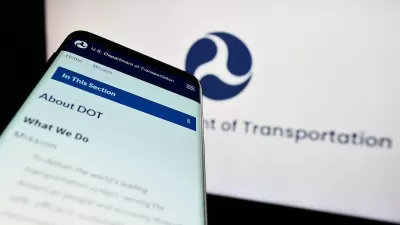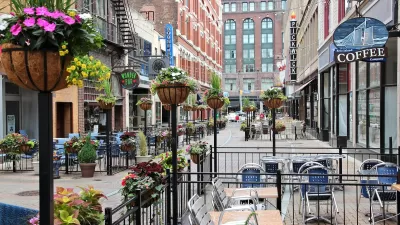Micheline Maynard writes about an AASHTO study showing that the share of American families who don't own cars had been declining since 1960 but stopped in 2007 at 8.7%. By 2011, it had budged up to 9.3%. She suggests four reasons for the reversal.
This essay is one of many that Maynard, a Forbes contributor, has written for her journalism project, Curbing Cars. Access to autos is just one of the findings found in "Commuting in America 2013: The National Report on Commuting Trends and Patterns", a 24-page study (PDF) written by the American Association of State Highway and Transportation Officials (AASHTO).
Maynard explains from the onset that the data is based on 2011 figures, and that "car free families are a distinct minority. The study shows that 34.1 percent of the nation’s households own one car, 37.5 percent own two vehicles, and 19.1 percent are three-or-more-vehicle households." I would add that a .6% budge may not be that notable - except that the number is on the rise, and that the 2007 turnaround is around the same time frame that marks "peak-driving", discussed here numerous times, particularly by millennials.
Notwithstanding "the high cost of owning and maintaining a car", Maynard suggests four distinct reasons for the increase in car-free families, with the relationship to population density being one of the most interesting. Links to below bullet points connect to five of the seven gallery frames.
- "A fascinating part of the study discusses the fact that as population density increases, cars become less available — a logical outcome of living in urban areas. About 30 percent of people who live in areas with 10,000 residents or more per square mile say they do not have access to cars. Likewise, pretty much everyone who lives in an area with fewer than 2,000 residents per square mile can get hold of a vehicle."
- "Lack of a driver’s license"
- "Access to other transportation" including bicycling
- Walkable communities making living car-free easier
While Maynard does not include the technology boom, particularly among millennials as one of the key reasons for reduced car ownership, the study does account for it, according to Maynard.
“Changes in alternatives to travel, such as communication substituting for travel and renewed interest in and availability of options such as transit, bike and walk, helped dampen interest in expanding auto ownership,” they wrote.
The AASHTO report and the reasons that Maynard attributes for the increasing share of families choosing to live car-free are important in that the findings are consistent with other studies showing a decline in per capita driving around (or before) 2007, as well as the nexus of car ownership to walkable communities and population density. We look forward to forthcoming studies to confirm whether the tide is indeed changing.
FULL STORY: 4 Big Reasons Why People Are Giving Up Cars

Study: Maui’s Plan to Convert Vacation Rentals to Long-Term Housing Could Cause Nearly $1 Billion Economic Loss
The plan would reduce visitor accommodation by 25,% resulting in 1,900 jobs lost.

North Texas Transit Leaders Tout Benefits of TOD for Growing Region
At a summit focused on transit-oriented development, policymakers discussed how North Texas’ expanded light rail system can serve as a tool for economic growth.

Why Should We Subsidize Public Transportation?
Many public transit agencies face financial stress due to rising costs, declining fare revenue, and declining subsidies. Transit advocates must provide a strong business case for increasing public transit funding.

How to Make US Trains Faster
Changes to boarding platforms and a switch to electric trains could improve U.S. passenger rail service without the added cost of high-speed rail.

Columbia’s Revitalized ‘Loop’ Is a Hub for Local Entrepreneurs
A focus on small businesses is helping a commercial corridor in Columbia, Missouri thrive.

Invasive Insect Threatens Minnesota’s Ash Forests
The Emerald Ash Borer is a rapidly spreading invasive pest threatening Minnesota’s ash trees, and homeowners are encouraged to plant diverse replacement species, avoid moving ash firewood, and monitor for signs of infestation.
Urban Design for Planners 1: Software Tools
This six-course series explores essential urban design concepts using open source software and equips planners with the tools they need to participate fully in the urban design process.
Planning for Universal Design
Learn the tools for implementing Universal Design in planning regulations.
City of Santa Clarita
Ascent Environmental
Institute for Housing and Urban Development Studies (IHS)
City of Grandview
Harvard GSD Executive Education
Toledo-Lucas County Plan Commissions
Salt Lake City
NYU Wagner Graduate School of Public Service





























